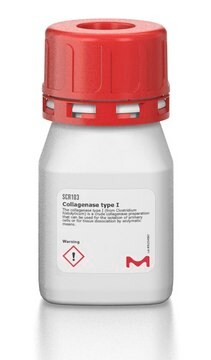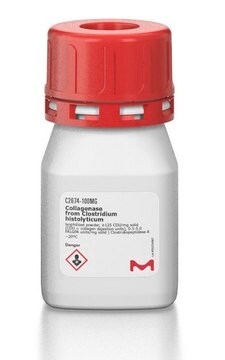Application
The enzyme has also been used along with other proteases for the disaggregation of human tumor, mouse kidney, human brain, and lung epithelial tissues. It is also useful in liver and kidney perfusion studies, digestion of pancreas, isolation of nonparenchymal rat liver cells and hepatocytes. The enzyme from Sigma has been used for the digestion of type I collagen from bovine trabecular and cortical bones. It has also been used as a positive control in FALGPA assay on Group B Streptococci cells.
Suitable for use in preparation of single cell suspension for sequencing.
Biochem/physiol Actions
Collagenase is activated by four gram atom calcium per mole enzyme. It is inhibited by ethylene glycol-bis(beta-aminoethyl ether) - N, N, N′,N′-tetraacetic acid, beta-mercaptoethanol, glutathione, thioglycolic acid and 8-hydroxyquinoline.
Effective release of cells from tissue requires the action of both collagenase enzymes and the neutral protease. Collagenase is activated by four gram atom calcium (Ca2+) per mole enzyme. The culture filtrate is thought to contain at least 7 different proteases ranging in molecular weight from 68-130 kDa. The pH optimum ranges from 6.3-8.8. The enzyme is typically used to digest the connective components in tissue samples to liberate individual cells. Collagenase treatment can cause some cells to die. Typically, concentrations varying from 0.1 to 5 mg/mL are used for digestion. The duration of reaction varies from 15 minutes to several hours for a satisfactory efficiency of cell dissociation without causing too much cell death. Krebs Ringer buffer with calcium and BSA is preffered and Zn2+ is required for activity. The enzyme recognizes the sequence -R-Pro-8-X-Gly-Pro-R-, where X is most often a neutral amino acid. Ethylene glycol-bis(β-aminoethyl ether)-N,N,N′,N′-tetraacetic acid (EGTA)4; β-mercaptoethanol; glutathione (reduced); thioglycolic acid, sodium; 2,2′-dipyridyl; 8-hydroxyquinoline, cysteine are known to inhibit the enzyme activity.
Caution
As supplied, this product is stable for one year at -20°C. There is no loss in FALGPA or protease activity in 30 days at 37°C, 50°C and -20°C. Solutions of crude collagenase are stable if frozen quickly in aliquots (at 10 mg/mL) and kept frozen at -20°C. Further freeze-thaw cycles will damage the solution. The product retains 100% activity over 7 hours when held on ice.
Unit Definition
One collagen digestion unit (CDU) liberates peptides from collagen from bovine achilles tendon equivalent in ninhydrin color to 1.0 μmole of leucine in 5 hours at pH 7.4 at 37 °C in the presence of calcium ions. One FALGPA hydrolysis unit hydrolyzes 1.0 μmole of furylacryloyl-Leu-Gly-Pro-Ala per min at 25°C. One Neutral Protease unit hydrolyzes casein to produce color equivalent to 1.0 μmole of tyrosine per 5 hr at pH 7.5 at 37°C. One Clostripain Unit hydrolyzes 1.0 μmole of BAEE per min at pH 7.6 at 25°C in the presence of DTT.
Preparation Note
This product is equivalent to first 40% ammonium sulfate fraction of Mandl, I., et al., J. Clin. Invest., 32, 1323 (1953). Solutions are typically prepared at 1-2 mg/mL in TESCA buffer (containing 50 mM TES, 0.36 mM Calcium chloride, pH 7.4 at 37°C.









![N-[3-(2-Furyl)acryloyl]-Leu-Gly-Pro-Ala](/deepweb/assets/sigmaaldrich/product/structures/805/876/96b5fb57-71c8-4c6b-b5d2-fafe7374cd85/640/96b5fb57-71c8-4c6b-b5d2-fafe7374cd85.png)